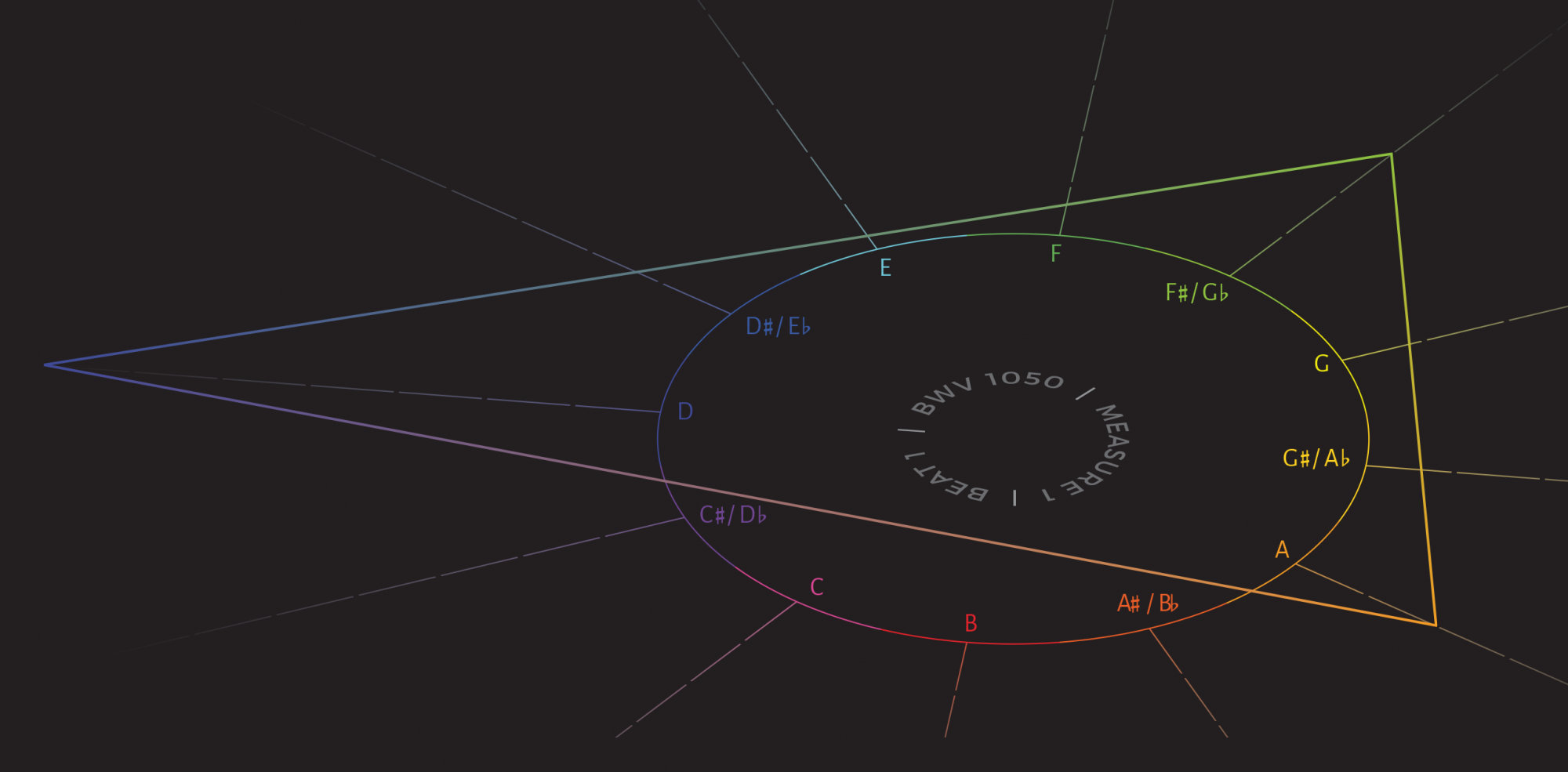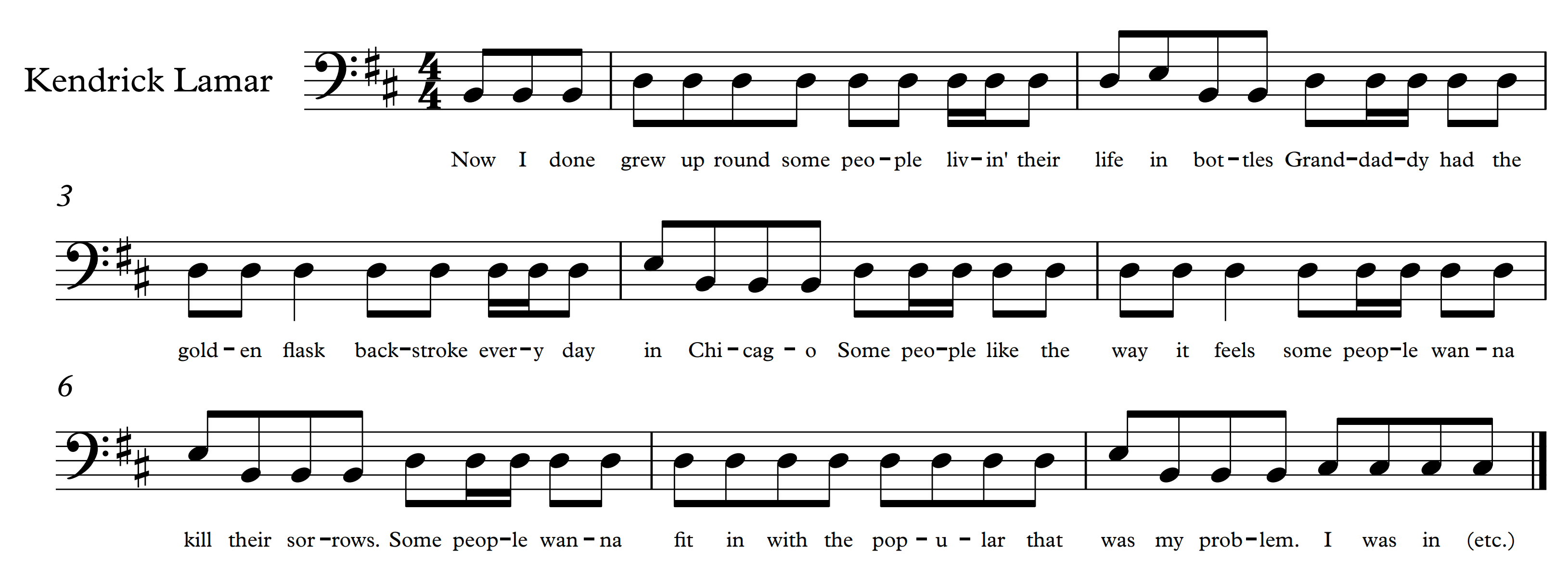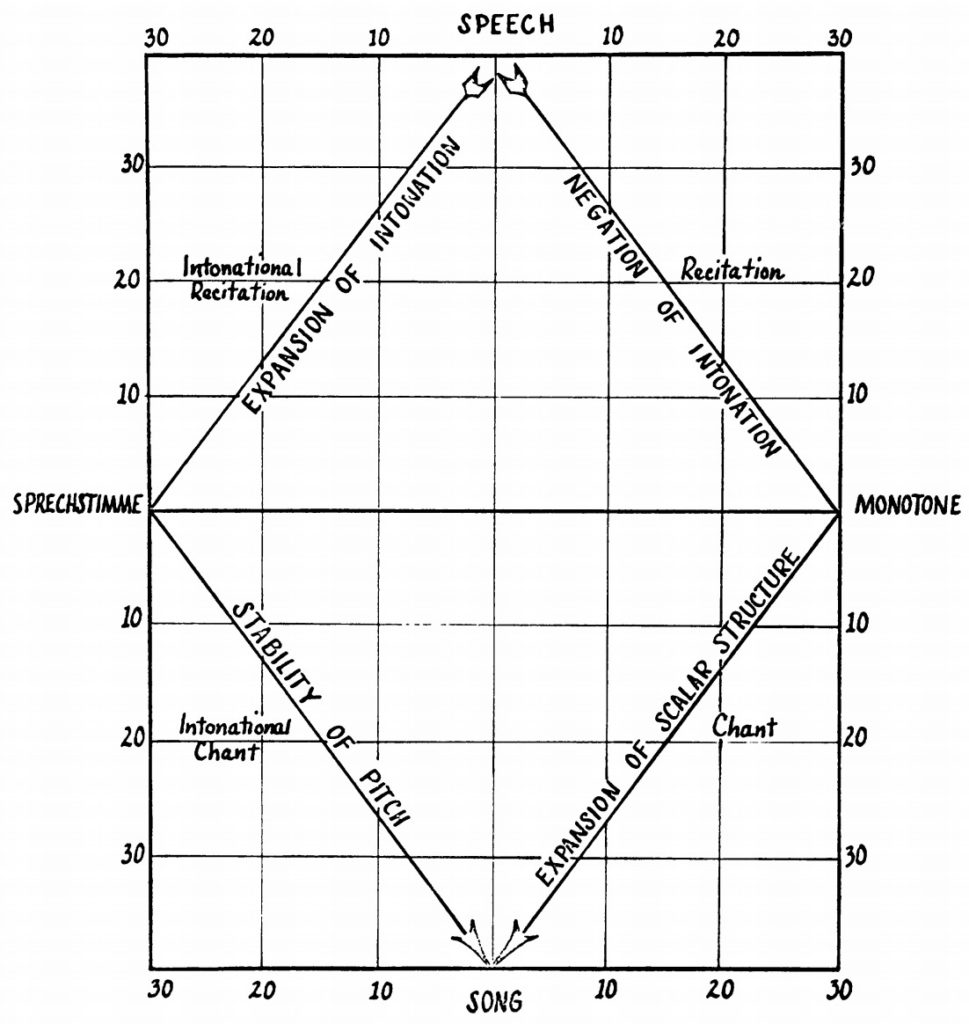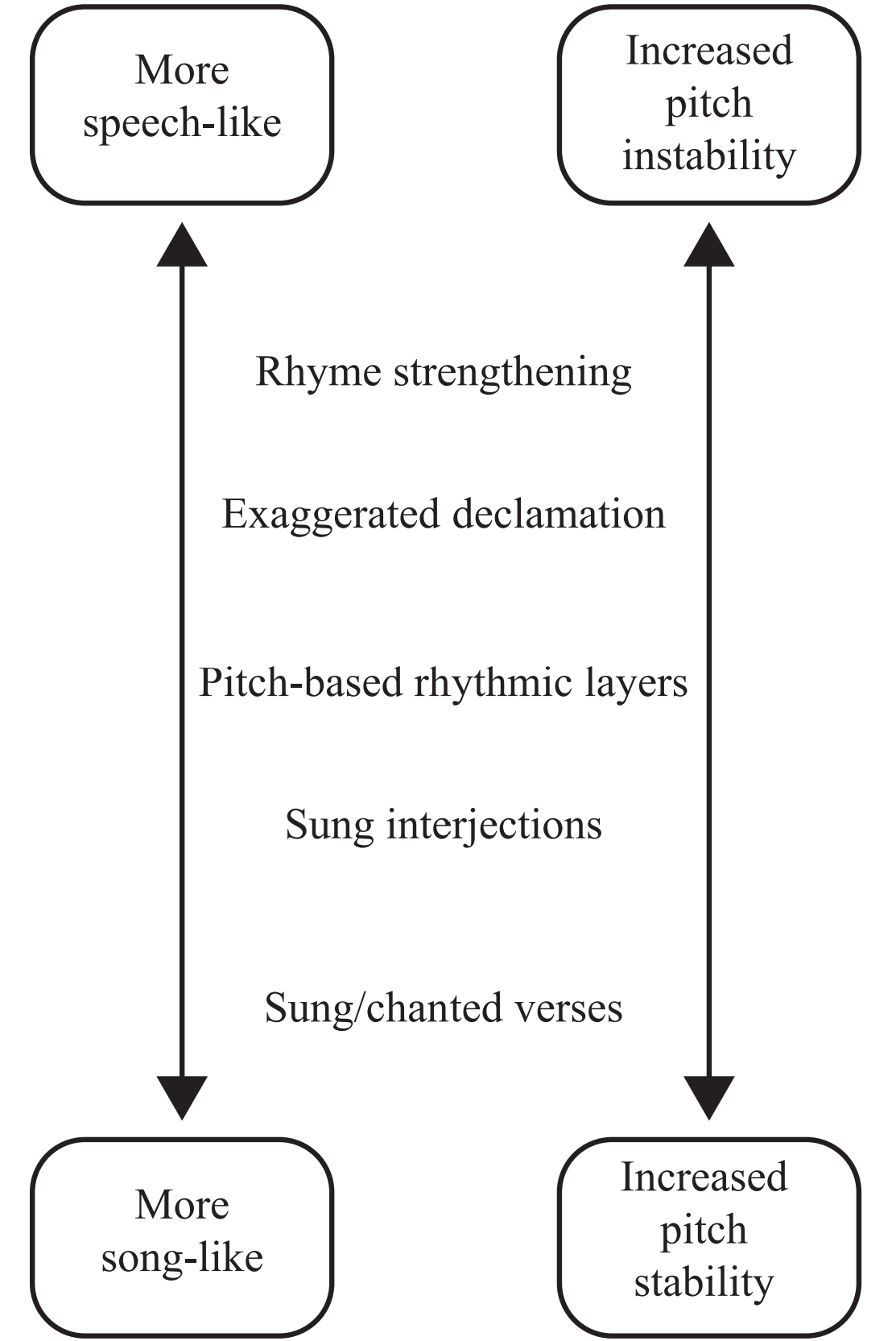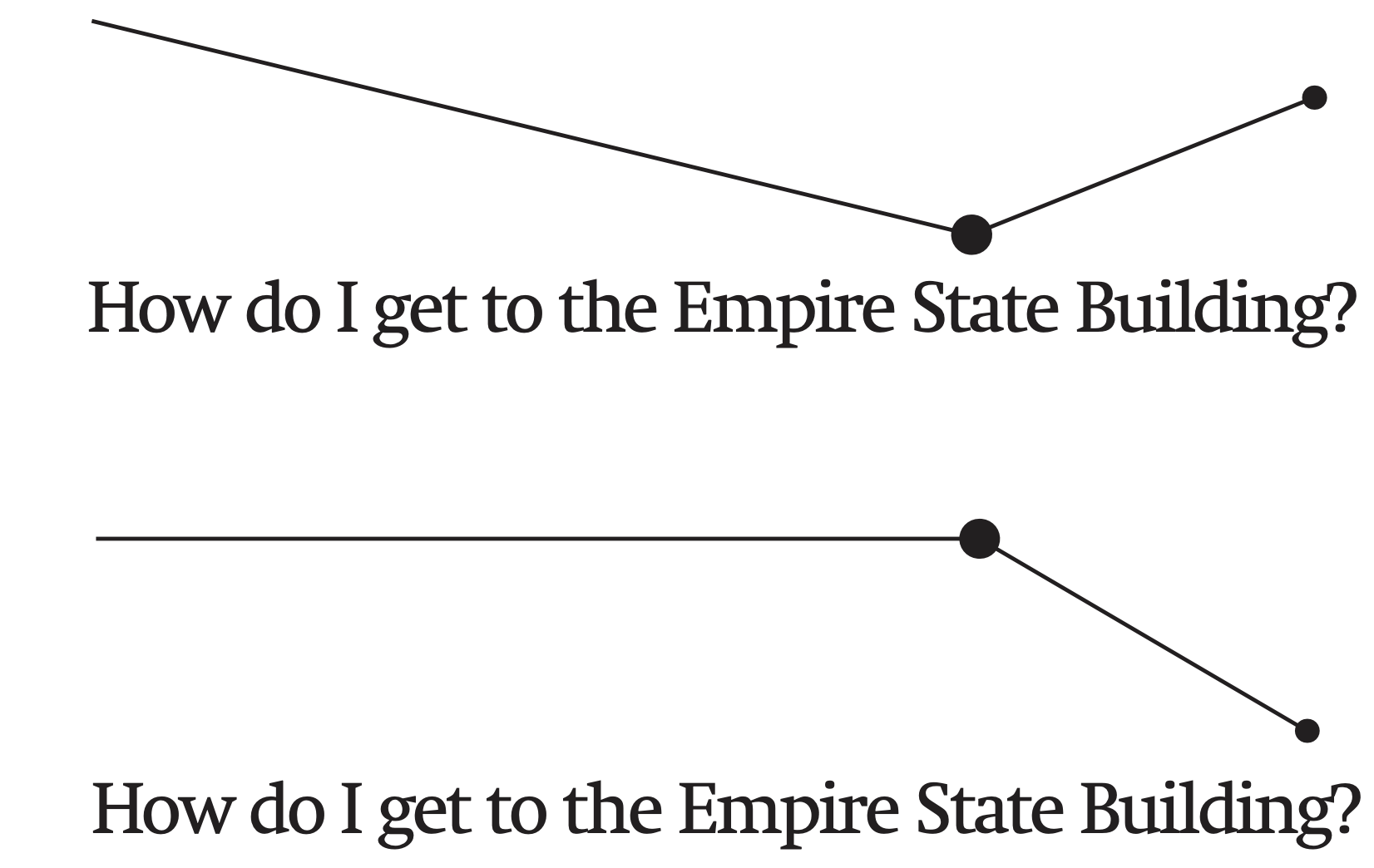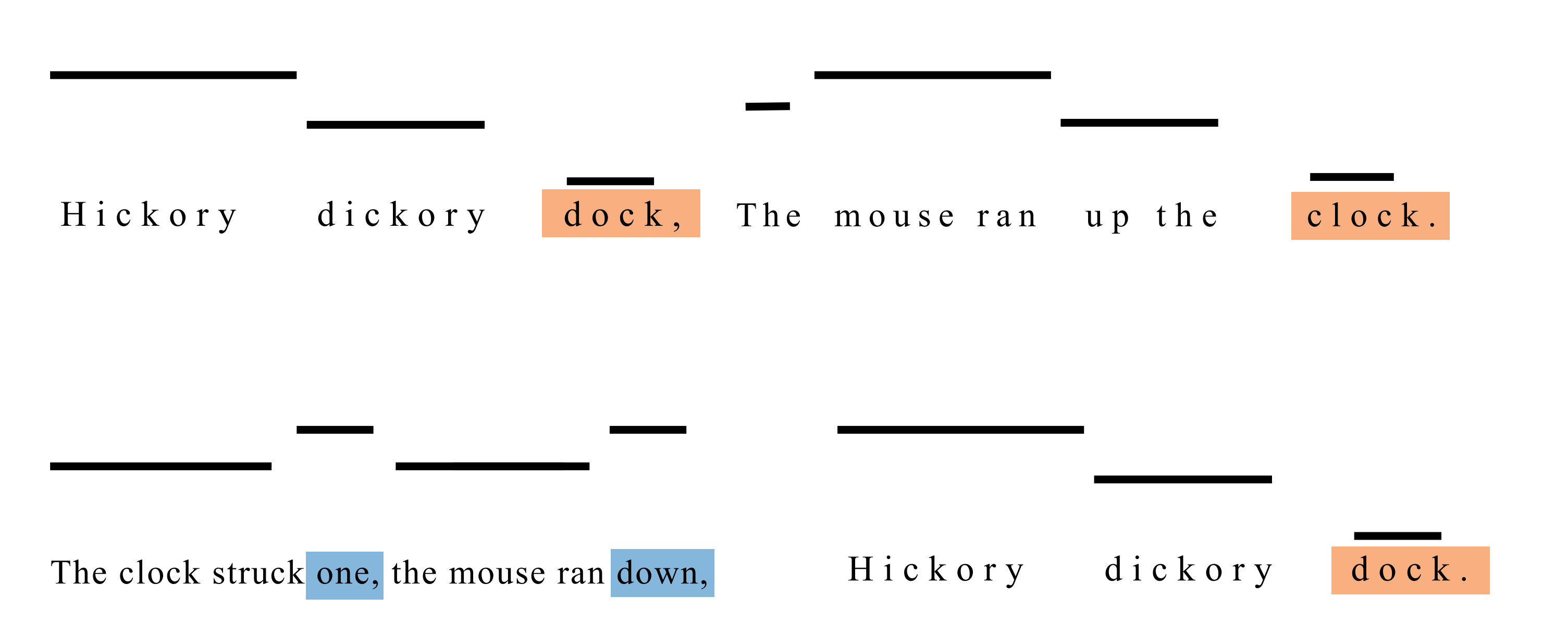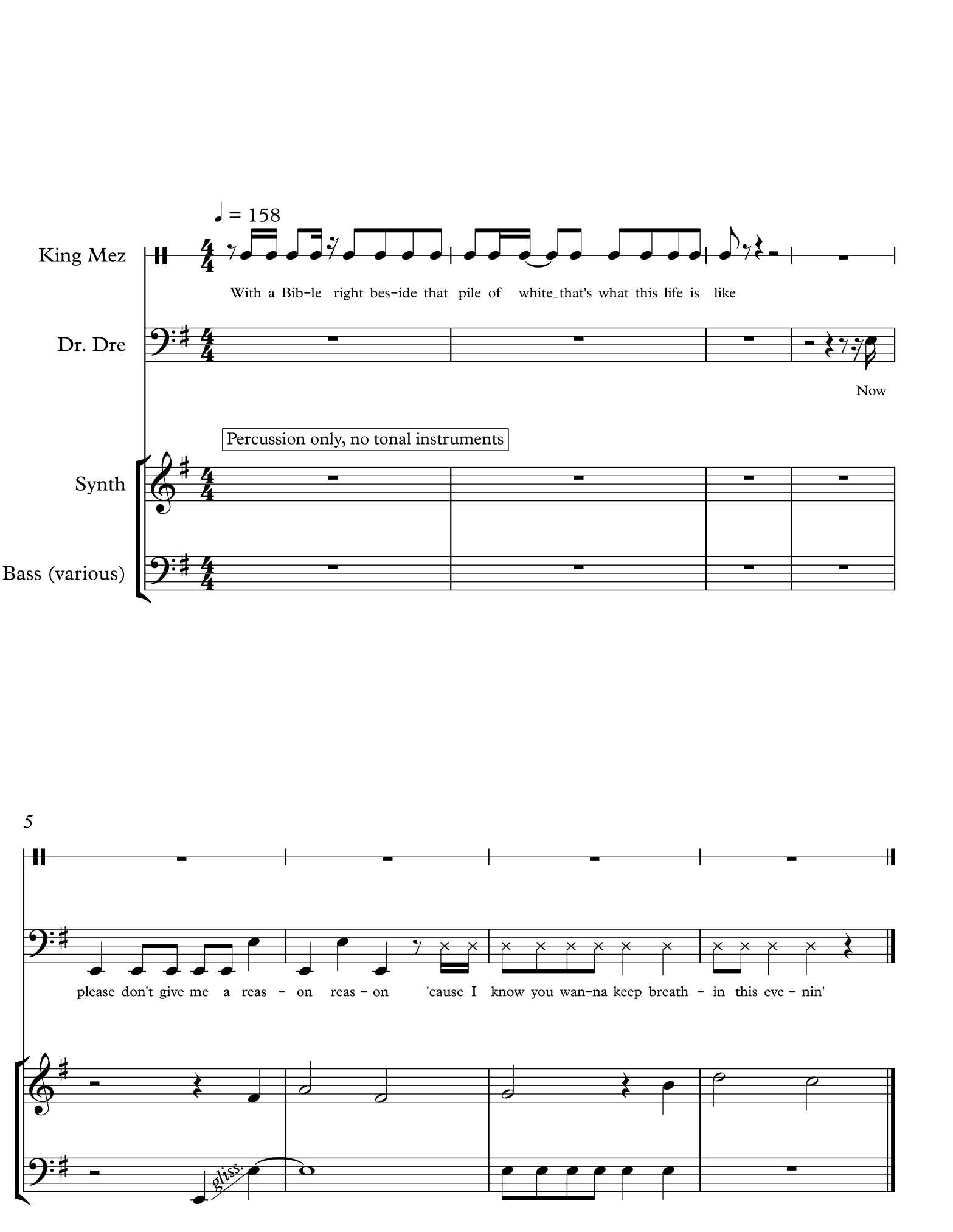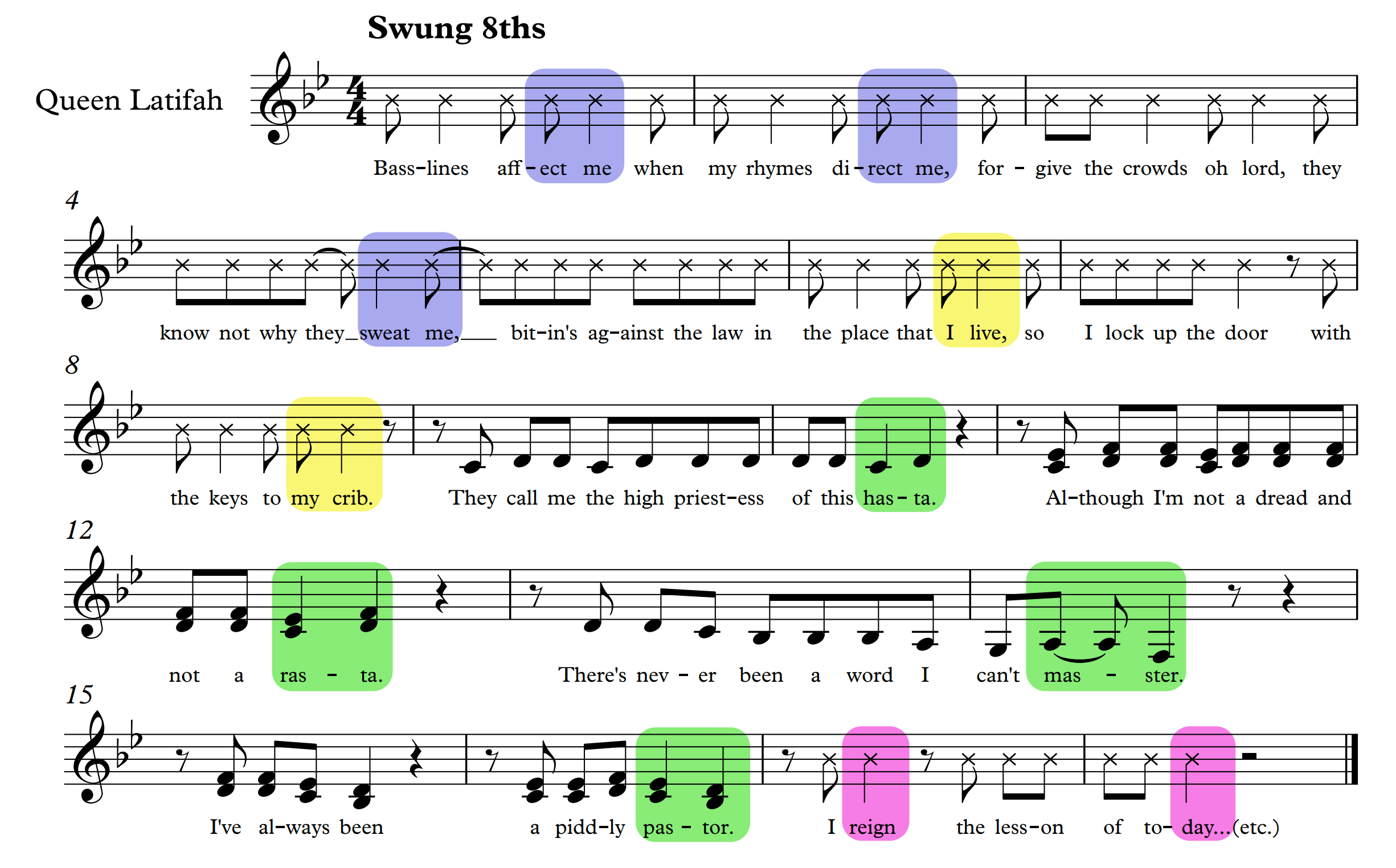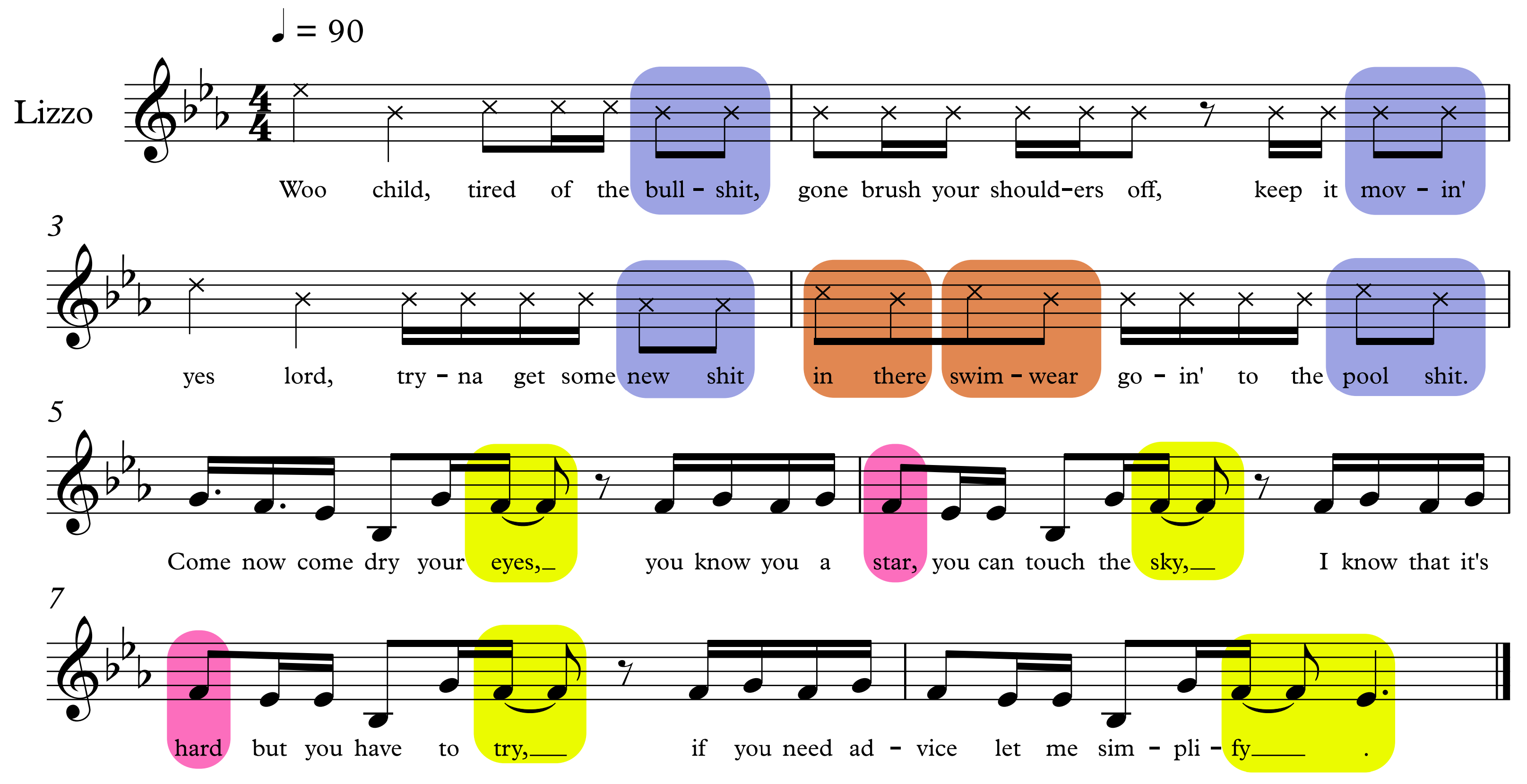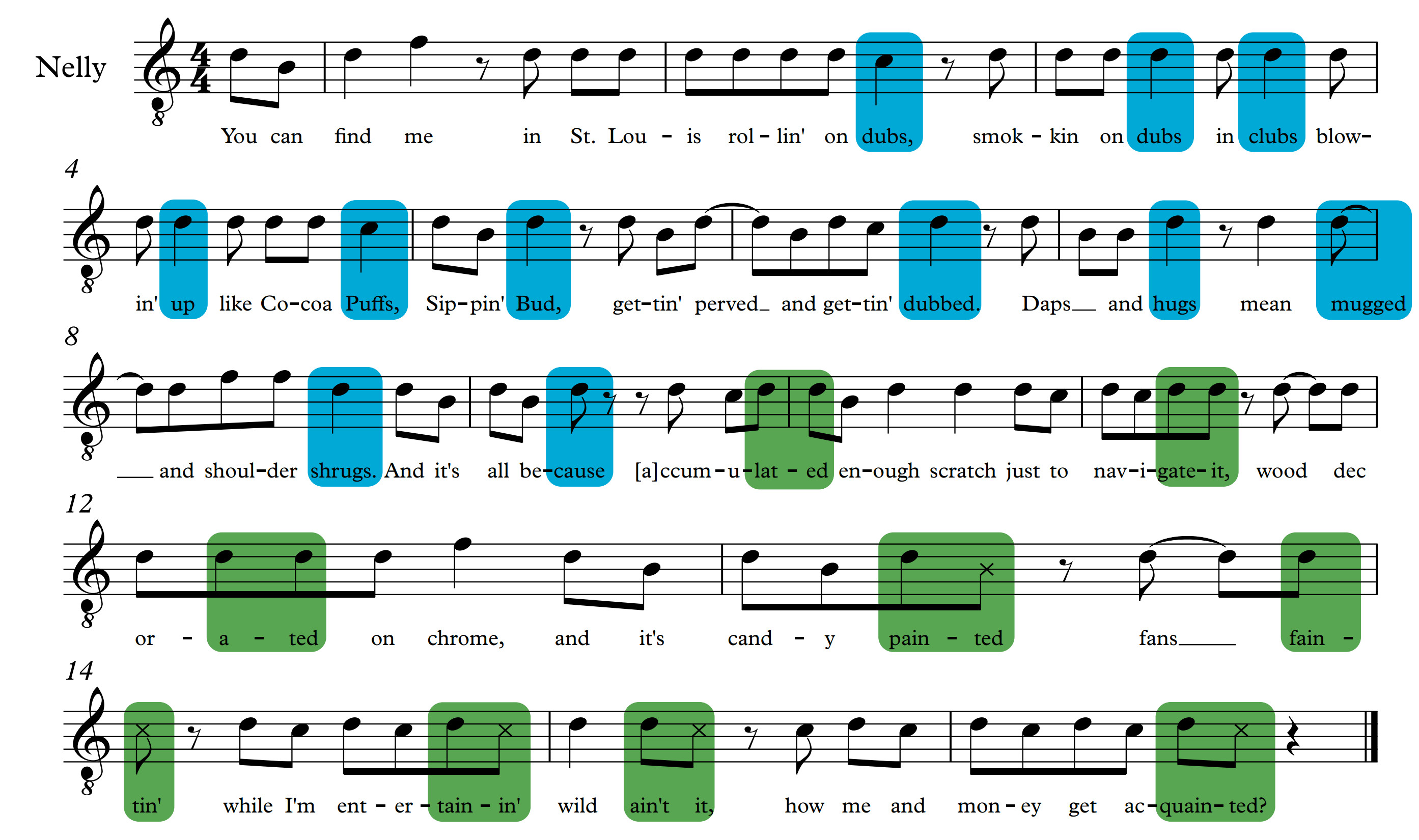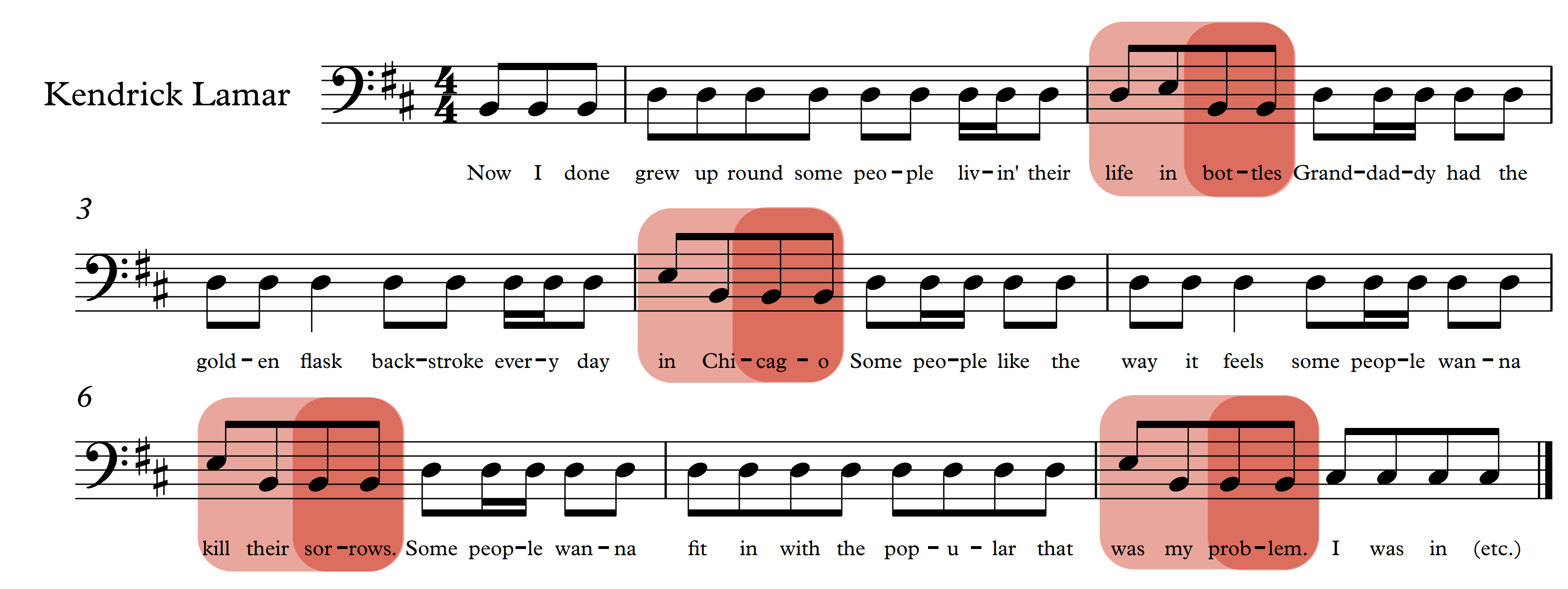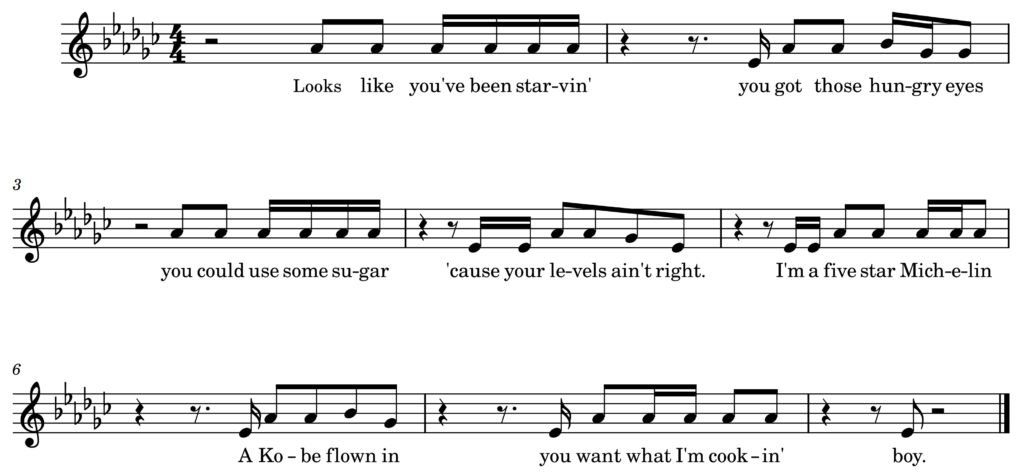Robert Komaniecki
Abstract
In this article, I argue that pitch plays an important role in the structure and delivery of rap flows. I demonstrate the ways in which rappers manipulate pitch to create a structural parameter that can operate independently from or in tandem with rhythm and rhyme. Furthermore, I argue that pitched vocals take a wider array of forms in rap music than in other genres of popular music, ranging from carefully-pitched singing of modern rap flows to the imprecise and exaggerated declamatory features of speech that distinguished rap from other genres during its formative years. I assert that all rap flows can be classified as using pitch in one of five different ways, with each technique carrying its own unique set of analytical implications.
View PDF
Return to Volume 34
Keywords and phrases: rap; hip-hop; pitch; voice
Suggested CitationOne of the defining aspects of rap music as a genre is its tendency to eschew the precisely pitched vocals heard in most popular music. We can accurately characterize much of rap music as rhymed prose, spoken rhythmically over a background track—like in Example 0a, a section of Kendrick Lamar’s “Poetic Justice” (2012). In the example below, the pitch of Lamar’s voice is ostensibly not carefully pitched—as is true in most rap.
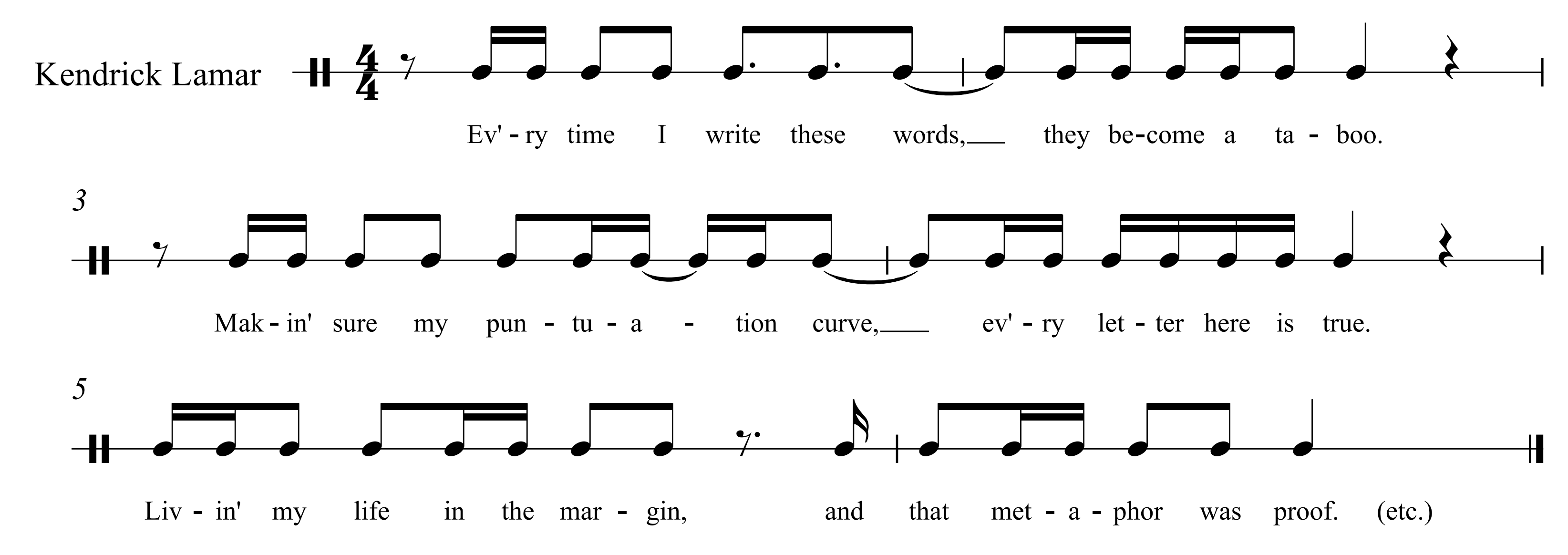
However, there are countless examples of rap tracks in which MCs are consciously pitching their vocals using a variety of techniques—emphasizing pitch in a way that paradoxically seems at odds with one of the very defining characteristics of rap music. Example 0b shows a song by the same artist and from the same year as Example 0a. In Kendrick Lamar’s “Swimming Pools (Drank)” (2012), the rapper pitches his vocals so that his verse takes on the guise of a quasi-melodic chant that adheres to a B minor tonic reinforced by the backing track.
The disparity in vocal pitch between two tracks by the same artist leaves us with many questions. To what extent should vocal pitch be considered when analyzing rap tracks? How do we differentiate between rapping and singing? What techniques do rappers employ to manipulate their vocal pitch in ways that are meaningful and musically impactful? These questions are the motivation for the present article.
While rap “flow”—a rapper’s delivery of the lyrics—has been the subject of an increasing amount of scholarship, the importance of vocal pitch as a parameter of flow is undertheorized. While the pitch of a rapper’s flow is technically no less quantifiable than rhythm or rhyme, it is less readily so when using typical music notation, making pitch perhaps a less attractive subject for analysis. This is because while rhythmic notation has theoretically infinite complexity, our standard pitch notation asks that we quantize notated pitches to one of twelve semitones. This leaves little room to notate the rapid pitch shifts that characterize spoken word.
As such, it makes perfect sense that the majority of music-theoretical scholarly attention thus far has been focused on musical characteristics that are both more readily-quantifiable and unique to rap, such as developing a typology of flow techniques (Adams 2009), attending to various issues via corpus studies (Condit-Schultz 2016; Ohriner 2016), and the interaction between rapped flow and produced beats (Adams 2008). While it is technically possible to quantify all pitches and rhythms in a rapper’s flow with the help of software, I have chosen to ground my analyses in observance of pitch done by ear. In doing so, I have offered descriptions of pitch in rap flows that are easily replicated in a classroom setting, or by an analyst basing their work on aspects of rap music that are more easily identifiable by ear.
In this article, I contend that pitch plays an important role in the structure and delivery of rap flows. In what follows, I demonstrate the ways in which rappers manipulate pitch to create a structural parameter that can operate independently from or in tandem with rhythm and rhyme. Furthermore, I argue that pitched vocals take a wider array of forms in rap music than in other genres of popular music, ranging from carefully-pitched singing of modern rap flows to the imprecise and exaggerated declamatory features of speech that distinguished rap from other genres during its formative years. I assert that all rap flows can be classified as using pitch in one of five different ways, with each type of pitched rap flow carrying its own unique set of analytical implications.
1. Introduction
While a rapper’s vocal pitch is the least-discussed parameter of flow in music-theoretical scholarship, it is nonetheless mentioned briefly by several writers. Discussing emphasis or accent in rap flows is connected to vocal declamation pitch, because one of the most common ways that rappers introduce accents is by raising the pitch of a word or syllable. Thus, nearly every rap analyst to date has mentioned vocal emphasis to some degree. Kyle Adams briefly discusses the purposefully pitched, melodic rap flows of Nelly, aptly comparing them with psalmody since they mainly take place on one or two repeated pitches (2009). Mitchell Ohriner mentions accented syllables in his corpus study on metric ambiguity in rap, though he stops short of including aspects of pitch in his data sets (2016). Condit-Schultz deals more intricately with vocal pitch in his own corpus study, including three pitch intonation features (2016). Condit-Schultz briefly discusses some of the ways in which vocal pitch can shape flows, including emphasizing certain syllables through pitch accents. Additionally, Condit-Schultz notes that “certain pitch intonation patterns contribute to the marking of phrasing boundaries” (130), much like the ways in which pitch impacts our perception of declamatory phrases (i.e., ending a question with an upwards glide in pitch). Finally, Condit-Schultz claims that pitch intonation can be used by rappers to create “musical parallelism[s],” working with additional parameters of rhythm and rhyme. Condit-Schultz ostensibly codes some of these parameters into his corpus analysis, but does not return to the issue of pitch in his article.
Ohriner’s 2019 article, “Analysing the pitch content of the rapping voice,” is the first extended discussion of vocal pitch in rap in musicological scholarship. In this article, Ohriner documents the various ways in which rapping differs from normal prosody by measuring the precise pitch content of select excerpts. Ohriner’s study is essential for any music-theoretical discussion of vocal pitch in rap, but differs greatly from my own not only in its goal (to demonstrate the ways in which rapping differs from prosody), but also in its methodology—Ohriner’s article showcases empirical data, including precise pitch measurements, while in the present article I am more focused on a humanistic analysis of pitch in rap music that is easily replicated without the aid of additional software or technology.
Much of the published commentary on vocal pitch in rap comes from rappers themselves, through the numerous interviews transcribed by Paul Edwards in his How to Rap (2009) and How to Rap 2 (2013). In these monographs, Edwards covers a wide range of topics with various rappers, touching on everything from rhyming techniques to stage presence. As the many observations on pitch in Edwards’ books vary in level of detail, I think it necessary to briefly outline his relevant contributions in this section, before threading it into my classifications of vocal techniques when appropriate.
As the audience of Edwards’ How to Rap books is ostensibly readers who are interested in learning how to rap themselves, Edwards frames the issue of pitch in rap flow as a means by which rappers can differentiate themselves from the competition. A unique voice, Edwards (2013) says, can help you sound “original and distinct” (61)—and pitch is a vital component of each rapper’s voice. Edwards lists rappers who have relatively high voices, singling out both B-Real of Cypress Hill and Eminem. “A higher pitch,” Edwards states, “cuts through the other musical elements of the track well and is often used for playful, fun deliveries” (62). Glossing over mid-pitched rappers, Edwards moves on to discuss MCs with deeper voices, such as Method Man and 2Pac, noting the increased aura of “authority” of such rappers (63). Edwards’ characterization of lower rap vocals as being more authoritative may be generally true, but numerous counterexamples exist. For example, Jay-Z, Eminem, and Danny Brown all have relatively high voices, yet generally rap in a way that could be considered “authoritative.”2 Conversely, rapper Chali 2na of the Jurassic 5 has an exceptionally low voice, yet is not particularly authoritative, certainly not more so than Method Man or 2Pac.
Moving on from these general classifications, Edwards then discusses ways in which rappers may choose to pitch their voice over the duration of a track, ranging from monotone to frequent peaks and valleys in a rapper’s vocals. Though Edwards does not state this outright, the implication in his writing is that when rap vocals have a wider pitch band, the result is a more expressive flow. Edwards includes a few observations about the potential benefits of monotonous rapping, however, saying that it is more ideal for speedy rapping and can make the voice sound more like a percussion instrument (not unlike the rapping that Adam Krims refers to as a “percussion-effusive” style (2000, 51)).
Later in his book, Edwards launches into a more exhaustive discussion of pitch possibilities in rap flows—telling readers that they can deliver certain syllables higher, lower, or change pitch during a single syllable in order to emphasize or deemphasize a word. Edwards even addresses variations of pitch that are natural in English speech, such as raising one’s voice at the end of a sentence if one is asking a question, or lowering the pitch at the end of a phrase to give a sense of phrasal and grammatical closure. Edwards also observes that rappers will occasionally gradually heighten their vocal pitch throughout a larger phrase or verse, giving listeners a sense of steadily increasing urgency. Edwards’ assertion that rappers can “[create] patterns with pitch” is perhaps most relevant to my own discussion of pitch as a parameter of rap flow. “Often, series of lower- and higher-pitched syllables or phrases will be used to create a pattern in the delivery,” Edwards writes. “This can be done to create a structure for the verse, in a similar way to how rhythm or rhyme is sometimes used (emphasis added)” (2013, 106). In comparing the use of pitch to rhythm and rhyme, Edwards makes a connection that few other scholars have, and one that I will return to shortly.3
2. A Spectrum of Pitch Techniques
All phonations are pitched. Any speech, laughter, whoop, grunt, or clearing of a throat could be theoretically mapped in pitch space. That said, not all phonations are pitched with the same level of intention. A soprano singing a heavily-ornamented da capo is more precisely pitched than an imprecise singer like Bob Dylan, whose own vocal performances are more precisely pitched than the average rap verse by Lil’ Kim. When analyzing the usage of pitch in rap flows, one must become familiar with a spectrum of pitch techniques employed by rappers, each yielding different results for the listener.4
While little scholarly writing compares rap flow to speech, the relationship between speech and song has been discussed at length in literature outside of the music-theoretical sphere, and scholars have acknowledged that speech is much more purposefully pitched than it might at first seem. In his article “The Boundaries of Speech and Song,” George List states that both speech and song are vocally produced, linguistically meaningful, and melodic (1963). List goes on to state that while tones of speech are “meaningful at the phonetic level,” they are “less susceptible to exact analysis than phonemes or tones” (2). List notates speech and song along a spectrum as shown in Figure 1, in which types of communication that share aspects of both speech and song exist somewhere in the middle of his diagram. While rap music did not exist at the time that List wrote his article, he differentiates between speech, song, and middleground types of communication, such as monotonous chanting or Sprechstimme.
Diana Deutsch further demonstrates the connection between spoken word and song with her well-known illusion, in which a spoken segment of a sentence is repeated until the listener perceives it as a tonal melody (1995). In this experiment, Deutsch records herself speaking a sentence normally, then isolates a segment in which she speaks the words “sometimes behave so strangely.” Deutsch plays the recording of her speaking this segment at regular intervals. As she does so, listeners begin to hear the sentence fragment as taking on musical characteristics. After several repetitions, most listeners hear Deutsch’s (not purposefully pitched) recording reproduced in Figure 2.
My proposed spectrum of five different pitch techniques in rap music is shown in Figure 3. I have arranged these techniques on a line, with techniques closer to the top of the diagram being imprecisely pitched as in typical speech, while techniques towards the bottom are more precisely pitched as in typical song. Brief definitions of each technique are as follows:
- Rhyme strengthening: In a declamatory style, pitching words or syllables so that rhymed lyrics also correspond to one another in pitch.
- Exaggerated declamation: Distorting or magnifying naturally occurring speech patterns in rap flows.
- Pitch-based rhythmic layers: Deliberately and markedly altering the pitch of one’s voice at specific points in their flow to create a separate rhythmic layer that is woven in with the composite rhythm of their flow.
- Sung interjection: Interrupting the tonally imprecise and speech-like pitch of one’s flow to sing a segment of lyrics.
- Sung/chanted verses: Performing the entirety of one’s flow on a pitch or set of pitches in accordance with the tonic from the track’s backing beat.
As rappers “move” along the continuum in Figure 2 from top to bottom, they rap with more specific pitches, progressing from flow that invokes speech to flow that invokes song. Rappers can and do use several of these pitch techniques simultaneously or in close proximity in a single track or verse, but for the purpose of this article, I will primarily focus on passages that exemplify one technique at a time. In the following sections, I will detail each of the five techniques in turn, supplying exemplary rap verses and commenting on the potential analytical usages for each. As I progress along the spectrum from least to most precisely pitched vocals, I will discuss the problematic boundaries between the vocal techniques of rapping and singing.5
2.1 Rhyme Strengthening
“Rhyme strengthening” refers to rappers altering the pitch of certain words or syllables in order to create aural connections between rhymed groups. In the context of rap analysis, “rhyme” can refer to more than traditional poetic rhyme. Generally speaking, we can say that areas of rap flow that have a strong perceived connection can “rhyme”—even if they don’t have rhyming vowel sounds. In the same way that we would say that certain aspects of visual art or architecture may “rhyme,” so we can say general aspects of rap flows can invoke “rhyme.” This said, most mentions of rhyme in this article will refer to traditional poetic rhyme.
As an example of rhyme strengthening through manipulating the pitch of rap flows, see Eminem’s “White America” (2002) in Examples 1a and 1b. In this example, I have used three separate lines of notation to denote the relative pitch of Eminem’s voice at a given moment.
This method of transcription is deliberately imprecise, and each line does not necessarily represent an exact pitch. Instead of prioritizing precision, I have chosen to notate some rap flows using percussion notation, where each line represents an approximate pitch “zone” in the rapper’s voice as it is heard on a given track. Even a cursory listen to the track will reveal that Eminem uses three pitch zones in the verse. From the listener’s perspective, relative pitch levels are more salient than absolute pitches, thus an analysis of the pitch content of this verse is best aided by approximating pitch placement, rather than by attempting to pinpoint pitches exactly. If we take the middle line in Examples 1a and 1b to be Eminem’s mid-range voice, then each note head that appears on the higher or lower staff lines represents a syllable rapped at a higher or lower pitch.
By notating Eminem’s flow using this method of pitch approximation, several analytical observations come to light. While the majority of Examples 1a and 1b are rapped in Eminem’s mid-range voice, a rudimentary pitch analysis reveals that there are two separate pitch streams functioning in the same phrase, each with their own unique set of rhymed syllables.
While every syllable that rhymes with “blue” (highlighted in gray) is performed at a relatively lower pitch level, anything that rhymes with the lyrics “baby” or “just like yourself” is rapped closer to the center of Eminem’s vocal range on this particular track.6 Separating the rhymed groups into disparate pitch levels allows listeners to more readily apprehend Eminem’s rhyme scheme in this verse, which is characteristically complex due to the rapper’s signature polysyllabic rhymes (e.g., “sits on the shelf” and “dimples would help”). An argument could even be made that there is a multi-pitch, multi-syllable rhyme between groups like “blue baby” and “lose Shady.”
It is difficult to say whether Eminem parsed his rhymes into discrete pitch levels consciously. While little scholarship on pitch in rap exists, there is an immense amount of writing on the subject of linguistic prosody, detailing the ways in which intonation, rhythm, tempo, and articulation shape our presentation and perception of speech. From this research, we know that much of the information conveyed in speech is done through manipulation of our vocal pitch. For example, see two different versions of a question in Figure 4 below. The first question is polite due to the rising pitch at the end, while the second sounds ruder to our ears.
I assert that pitch conveys two types of information in rap flows: In addition to simply conveying the meaning of lyrics to the listener as in speech, the pitch of rap vocals also helps to connect rhymed syllables to one another, highlighting a rapper’s rhyme scheme.
Using pitch to highlight rhymed syllables may be a conscious decision on Eminem’s part, but it could just as likely be an instinctive inflection due to the rhymed syllables in his lyrics. We can test our own instinctive usage of pitch in rhymed verse by reciting a simple limerick, such as “Hickory Dickory Dock.” My own vocal inflections follow the contour shown in Figure 5 below.
As shown in the diagram above, I tend to instinctively pitch rhymed syllables at approximately the same level as one another when reciting poetry or verse. Reciting the words “dock” and “clock” at the same pitch level highlights them as a rhymed pair to listeners. Readers can experiment with pitching rhymed syllables at dramatically different levels to highlight how unintuitive this seems to our ears.
When surveying rap tracks across decades and sub-genres, it becomes clear that rhyme-strengthening pitch techniques are extremely prevalent, strengthening the impression that this technique is to a certain extent instinctual. Example 2 shows an excerpt of Tech N9ne’s “Erbody But Me” (2016), in which the rapper uses his vocal pitch to emphasize rhymed syllables.
Tech N9ne’s flow is generally pitched near the middle of his vocal range in this track. However, for every two-syllable rhyme in Example 2, the rapper creates a pitched correspondence in addition to the rhyming syllables. A “high-low” precedent is set on the word “drinkin’,” and each subsequent rhyme follows the same pitch pattern, with none of the connecting non-rhymed syllables intruding upon the pitch space that Tech N9ne reserves for his rhymes in this section. As the rapper continues in this track, he exaggerates this technique further, and begins to shout rhymed syllables, making them stand in even more stark contrast against his calmer, mid-range “base” flow (Example 3).

Example 4 shows a curious extension of the rhyme-strengthening vocal pitch from Doja Cat in her track “Rules” (2019). Doja Cat’s rhymes are marked via her vocal pitch, but not every rhyme is pitched at the same level—instead, she alternates between pitching rhymed syllables at the relative lowest and highest parts of her vocal range. The aesthetic result is similar to the previous examples, in that listeners are able to more easily pick out rhymes that are emphasized via their placement in the rapper’s vocal range, and a novel low/high pattern is created that repeats in each of the four bars shown.7
Example 5 illustrates a final example of rhyme-strengthening vocal intonation. In “California Love” (1996), Tupac marks rhyming syllables “program” with another notable instance of “high-low” vocal pitch.8
In Example 5, I have chosen to notate the highest and lowest pitch zones using the spaces above and below the middle line, due to Tupac using a slightly narrower pitch band in his flow than either of the previous examples. Tupac’s use of rhyme-strengthening pitch in Example 5 is notable because his use of pitch creates a connection between two seemingly disparate sections of his verse. After rapping four lines whose ends rhyme with “program” (highlighted in green in Example 5), Tupac introduces a new rhymed syllable, beginning his next chain by rhyming with the word “say” (highlighted in purple below). However, at the end of this new rhymed chain, Tupac raps the word “Oakland” at the same relative pitch level that he did his initial rhymes (in green) from earlier in the verse.
Example 5 demonstrates the power of relative vocal pitch levels, even if they are imprecise, in creating aural connections within rap verses. Ohriner (2016) discusses the “upper limit” to our perception of rhyme in rap music. Ohriner’s position is a logical one: Listeners can only make connections between rhymed pairs if the pairs are within a certain temporal distance of one another. If a rhymed pair is split up by a large enough section of interpolated lyrics, we won’t hear the pair as being rhymed at all. Usually, the “upper limit” for our perception of rhyme is relatively short, even more so when a verse is packed with as many rhymed syllables as Tupac’s is in “California Love.” However, in imbuing his rhymed motive with a vocal pitch motive, Tupac allows listeners to connect the lyric “Oakland” to the earlier rhymes in his verse with the same pitch contour, highlighted in green. As is demonstrated in Example 5, manipulation of pitch can not only draw attention to existing rhymes, but it can strengthen connections between slant (i.e. partial) rhymes.9
2.2 Exaggerated Declamation
Similar to the first pitch technique described above, exaggerated declamation is an outgrowth of speech patterns found in rap. More specifically, exaggerated declamation refers to the deliberate distortion or magnification of naturally occurring speech patterns in rap flows. This technique is rather like the more familiar Sprechstimme in that both exaggerate typical speech patterns—however, exaggerated rap declamation is not directed by a score, while Sprechstimme is. When English speakers speak declamatory sentences, it is typical for the pitch of their voice to drop during the final few words (Celce-Muria et al. 1996).10 This phenomenon received some scholarly attention due to its contrast with the relatively new “High Rising Terminal” (HRT) speech pattern, more commonly referred to as “upspeak,” in which speakers will raise the pitch of their voice at the end of their sentences (Ladd 1996).11 In rap flows, normal declamation patterns are sometimes elongated or exaggerated—perhaps we could term this phenomenon “Sinking Terminal.” These declamatory drops in pitch can happen suddenly, or be stretched out over entire phrases or stanzas.
Example 6 shows a transcription of Kendrick Lamar’s guest verse in “Vice City” (2015) by Jay Rock. While Lamar’s pitch levels are imprecise, they are exceptionally marked—the ending of each line is not only separated in terms of rhythm, but in pitch as well. Indeed, Lamar purposefully and repeatedly drops the pitch of his voice at the ending of each line, sometimes lowering his voice by more than an octave—a clear exaggeration of the Sinking Terminal phenomenon that would occur naturally if he were simply speaking the lyrics.
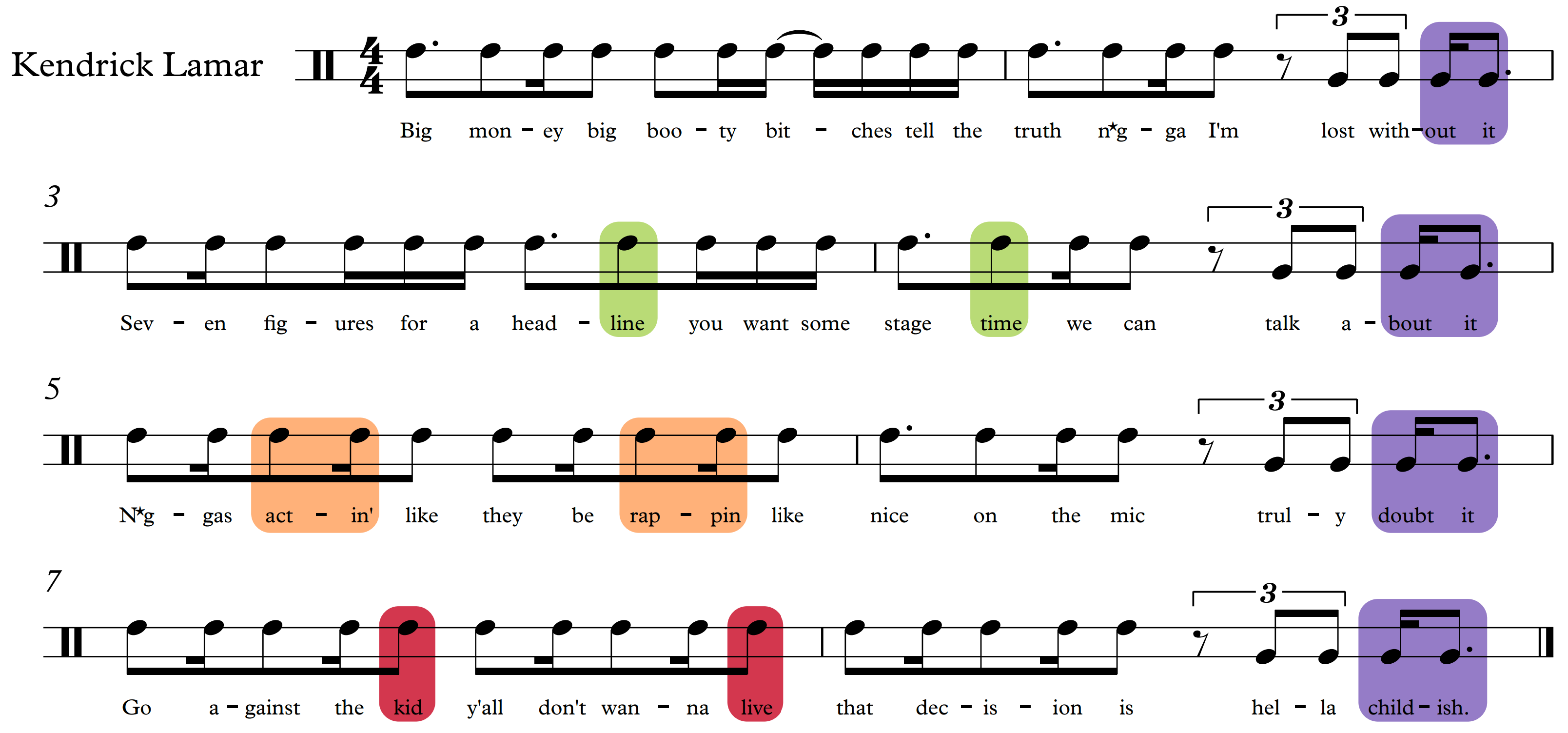
Similar to the rhyme-strengthening phenomenon mentioned previously, Lamar’s dramatic drop in vocal pitch at key moments gives his verse a signature motive. Lamar’s halting, rhythmically loose flow has been referred to as “Obama flow” in some hip-hop fan circles (Genius), due to its resemblance to President Barack Obama’s occasionally halting speech cadence. Indeed, Lamar’s unconventional flow on the first verse of “Vice City”—a segment of which serves as a refrain throughout the track—seems to have influenced other rappers on the track, each one of whom structures their flow in a similar way.12
Example 7 shows an excerpt from Schoolboy Q’s verse on the same track, in which he imitates Lamar’s exaggerated declamation in his delivery. Similar to example 6, the rapper uses vocal pitch techniques familiar to us from everyday speech in order to cultivate a type of quasi-tonal resolution at the end of each phrase, as if he is finishing a thought.

Example 8 shows a novel intra-track development of Kendrick Lamar’s exaggerated declamation in “Vice City.” Lamar raps the first verse in the track, and is immediately followed by rapper Jay Rock performing the track’s second verse. Jay Rock begins by closely parroting Lamar’s “Obama flow,” dropping the pitch of his voice on end-rhymes, and rhythmically separating these moments from the rest of his lyrics. However, after following Lamar’s vocal pitch precedent for several lines, Jay Rock inverts the pattern, speaking several end rhymes high in his falsetto range.
Raising the pitch of one’s voice during speech can convey surprise, urgency, or disbelief, and Jay Rock’s exaggerated declamation during the latter half of his verse in “Vice City” reinforces these emotions—especially in relation to Lamar’s previous declamation; listeners are left with the impression that Jay Rock heard Lamar’s flow, appropriated it, and modified it so that his verse was unique.13
Similar to the rhyme-strengthening pitch technique, exaggerated declamation is common across rap genres and decades, again likely due to its close relationship to typical speech. Exaggerated declamation is not only done to strengthen rhyming groups of syllables, however. Additionally, contrary to Examples 6 and 7 above, not all examples of exaggerated declamation involve pitching one’s voice down at the end of a section of lyrics.
While Kendrick Lamar and Schoolboy Q used speech-like pitch to “resolve” phrases at the end of rhymed lines, rapper Snow Tha Product uses an exaggerated declamatory style in her track “Get Down Low” (2016) to achieve the opposite effect. Example 9 shows the way in which Snow Tha Product gradually increases the pitch of her voice from line to line, forgoing rhyme-strengthening vocal pitch in exchange for a sense of quickly mounting tension.
In Example 9, the primary end-rhyme syllables are highlighted in green. As is shown, Snow Tha Product eschews the tendency to pitch each of these words/syllables (“state,” “shape,” etc.) at the same level. Instead, every new occurrence of a green-highlighted rhymed syllable is marked by the rapper’s voice raising in pitch. Snow Tha Product is not raising her voice by a specific interval each time, nor is she rapping in a perfect monotone between pitch shifts. Thus, the net effect of this exaggerated declamation on Snow Tha Product’s flow is that it imbues the lyrics with a sense of urgency and building tension, which is not released until after the transcribed excerpt finishes on the word “spray” delivered in a high-pitched shout.14
2.3 Pitched Rhythmic Layers
When a rapper creates a pitched rhythmic layer, they deliberately and markedly alter the pitch of their voice at specific points in their flow to create a separate rhythmic layer that is woven in with the composite rhythm of their flow. The net effect of this technique is the sensation that two rhythmic layers are progressing simultaneously and dependently—one signified by the general pitch of a rapper’s flow, and the other signified by an altered or unusual pitch at select moments. An Edwards (2013) quote from earlier in this article bears repeating: “Often, series of lower- and higher-pitched syllables or phrases will be used to create a pattern in the delivery. This can be done to create a structure for the verse, in a similar way to how rhythm or rhyme is sometimes used (emphasis added)” (106). In the examples that follow, we will see moments where rappers are able to erect two simultaneous rhythmic patterns, differentiating between the two of them using their vocal pitch.
For a relatively straightforward example of this technique, see Eminem’s “The Ringer” (2018) in Example 10, in which Eminem uses his vocal pitch to strongly emphasize the first and third beat of each bar. The regularity of Eminem’s pitched rhythmic layer contrasts his usually irregular and complex rhyme schemes, and is underscored by an atypically straightforward set of end rhymes. Similarly, Example 11 shows the way in which rapper Twisted Insane uses vocal pitch in the track “200 Round Clip” (2015) to emphasize all four beats of each measure, de-emphasizing the underlying patter of steady sixteenth notes in favor of the background quarter note pulse.
A more complex example of pitched rhythmic layers can be seen in Example 12a—another transcription of Kendrick Lamar, this time from his guest verse in Dr. Dre’s track “Deep Water” (2015). In this brief section from a larger featured verse, Lamar markedly alters the pitch of certain syllables, placing them high in the falsetto part of his vocal register, approximately an octave higher than the surrounding lyrics. The result is a moment that sounds more complex than it looks on paper—Lamar distills a secondary rhythmic stream from his rapid, sixteenth note flow. The secondary rhythmic stream can be seen in Example 12b—note how the more widely-spaced attack points and syncopation contrast the mostly consistent deluge of sixteenth notes in the transcription in Example 12a.
Pitched rhythmic layers are by far the least common of the five types of pitch manipulation I have identified in rap music. This could be for a variety of different reasons. Perhaps its position on the middle of my spectrum that stretches from “more speech-like” to “more song-like” means that pitched rhythmic layers are least intuitive in terms of both musicality and speech. While I suggest that rhyme strengthening via vocal pitch occurs intuitively, it would be difficult to make such an argument for pitched rhythmic layers. Likewise, the pitched rhythmic layers above bear little resemblance to typical singing in pop music. It is possible that the “unnaturalness” of pitched rhythmic layers is the best way to explain their relative scarcity in hip-hop music.
2.4 Sung Interjections
A sung interjection is a moment in which a rapper interrupts the tonally imprecise and speech-like pitch of their flow and sings a segment of their lyrics. This fourth category of pitch manipulation in flow is the first in this article in which there is a purposeful and precise adherence to the ideas of a scale or tonic, since the pitches involved always have a clear tonal relationship to the underlying beat. Example 13 is a transcription from Dr. Dre’s track “Darkside/Gone” (2015), featuring Kendrick Lamar, Marsha Ambrosius, and King Mez. The section transcribed in Example 13 is the seam between two verses in “Darkside/Gone,” the first performed by guest rapper King Mez, the second performed by Dr. Dre himself. The tonic key of the section is E minor, and Dr. Dre fittingly comes in on the pitch E, bouncing between two octaves in a sung interjection before continuing in a more typical declamatory fashion.
Since rap music’s advent, there have been artists that blur the line between rap and R&B genres, splitting their time in a verse between less purposefully pitched rapping and more precise singing. Example 14 shows a transcription of Queen Latifah’s “Princess of the Posse” (1988). While Latifah is more active today as a singer and actress, she began her entertainment career as a rapper in the late 1980s, mixing hip-hop with soul while rapping about black women’s issues. In Example 14, after several bars of rapping in a verse, there is a brief, diatonic interjection (one that is harmonized by backing vocals, in Latifah’s case), followed by a continuation of less purposefully pitched rap flow.
Example 15 shows a transcription from rapper/singer Lizzo’s track “Good as Hell” (2016). Lizzo begins her track with several bars of rapping in declamatory tone, then switches to traditional singing for the majority of the song. Freely flitting between R&B, soul, and rap tropes (sometimes within a single track) is increasingly popular with recent “crossover” acts like Lizzo, Chance the Rapper, Drake, Noname, and many others.
The increased presence of singing in rap verses could be indirectly attributed to the “sung hook” gaining popularity amongst rappers and labels since the late 1990s. In rap’s earlier years, there little consensus on what should constitute a chorus (i.e. “hook”). Hooks could be comprised of a rapped refrain, singing, scratching, or a sampled instrumental. Some tracks omitted a refrain entirely. Despite this variety of refrains, it was the sung hook that eventually became predominant in the hip-hop sphere. “It Takes Two” by Rob Base and DJ EZ Rock (1988) is an early example of a sung chorus, in which Rob Base raps the verses, and the chorus is sung by Rhonda Parris.15 The formula of rap singles featuring a vocalist on the hooks increased in popularity, becoming what Michael Berry (2018) considers a “standard” form in hip-hop after 1995.16
Additionally, as sung hooks became more common, rappers even began experimenting with singing their own hooks. Results were mixed, as many commercially successful rappers were not trained singers. Rapper Ja Rule takes credit for this trend, saying “I think for the people, that’s what made it popular, that they were able to sing along with it and they weren’t intimidated by singing along to it because it was a guy that can’t sing” (2011).17
2.5 Sung/Chanted Verses
The fifth and final category of pitched rap flow is furthest removed from normal speech. In a sung or chanted rap verse, the rapper will perform the entirety of their flow on a pitch or set of pitches in accordance with the tonic from the track’s backing beat. As mentioned in Section 1, Adams (2009) has remarked on this chanted flow technique in the music of rapper Nelly, noting that it is “oddly reminiscent of psalmody,” a syllabic text setting of chant or sacred canticles. When one examines Nelly’s performance on “Country Grammar” (2000) in Example 16, the comparison with psalmody is apt with regards to text setting. The verse is almost completely purposefully pitched, save for a few spoken, unaccented syllables scattered throughout. These unstressed syllables are nearly always pitched lower than the surrounding syllables, and often occur on schwas, blending the line between speech and song as Nelly clearly emphasizes stressed syllables with a pitch adhering to the background tonic. As is evident in the transcription, the verse is primarily syllabically set, free of melisma—a characteristic shared with most of Nelly’s rapping throughout his career. If one were to place Nelly’s vocals in “Country Grammar” in the context of a complete musical scale, a likely choice would be D Dorian—which, while not entirely realized by Nelly’s vocals, is established by the song’s chorus and backing track.
In a 2010 interview with Complex magazine, Nelly framed himself as the progenitor of sung/chanted rap verses. Interestingly, Nelly characterizes his choruses as being sung, while the verses are rapped, despite both being deliberately pitched in the majority of his music:
It’s crazy; we did Billboard‘s “top artists of the decade,” and they asked me, “Who do you think is one of the biggest influences on music today?” And I was like, ‘Shit…me!’ I mean, let’s just be real about it! Who else was doing it like that? Who else was singing on hooks? And rapping on verses? Putting bridges in the songs and doing it like that? I mean whether I get the credit or not, it don’t matter (Nelly 2010).
Nelly echoed a similar (albeit less boastful) sentiment in his interview with Paul Edwards (2013). Edwards, who characterizes Nelly’s delivery as “half-sung,” quotes Nelly as stating that he considers his delivery to be a combination of R&B and rap, one of the “distinctive things” that Nelly was able to do as an artist (Edwards 2013, 142). Nelly’s success in the early 2000s is influential in as of itself—his 2000 debut album Country Grammar was certified diamond in 2016 by the Recording Industry Association of America (RIAA), placing him in an exclusive group of top-selling rappers that includes 2 Pac, Notorious B.I.G., and Eminem.
While Nelly certainly influenced his successors with his sung style of rapping, it would be disingenuous to frame him as the first to have success using sung vocals in hip-hop tracks. In fact, sing/rapping has occurred with some regularity for decades, likely due to the hip-hop’s close association with soul and R&B. Rapper Shock G states that “[there] was the ‘80s wave of hybrid hip-hop groups and melodic MCs, like Jimmy Spicer, Planet Patrol, Full Force, Jonzun Crew, […] and especially Queen Latifah, who took rap-singing to a whole ‘nother level of believability and harmonic accuracy when she dropped the game-changing ‘Wrath of My Madness/Princess of the Posse’ single in ’88” (Edwards 2013, 142). Indeed, Latifah’s blend of rapping and singing in Example 14 is clear indication that mixing the vocal styles in a single track, or within the same verse, had an ample precedent by the time Nelly released Country Grammar some two decades later.
Even Nelly’s signature style of rapping primarily on a single note with occasional motion to nearby pitches was established well before the new millennium. Hip-hop group Bone Thugs-n-Harmony popularized this style of rapping as early as 1991, calling it “rapping and singing at the same time” in interviews (Mansell, 2015). Example 17 shows a short excerpt of group member Bizzy Bone’s verse in Bone Thugs-n-Harmony’s biggest commercial success, “Crossroads” (1996). Bizzy Bone’s flow is remarkably similar to Nelly’s—both rappers perform the lyrics nearly exclusively on a purposefully pitched set of several notes, heavily syllabic, and adhering closely to the tonic established by the backing beat. Unlike Nelly, however, Bizzy Bone primarily performs on the dominant scale degree, rather than tonic—but his fellow Bone Thugs-n-Harmony groupmates emphasize each pitch of the tonic triad in turn throughout the track.
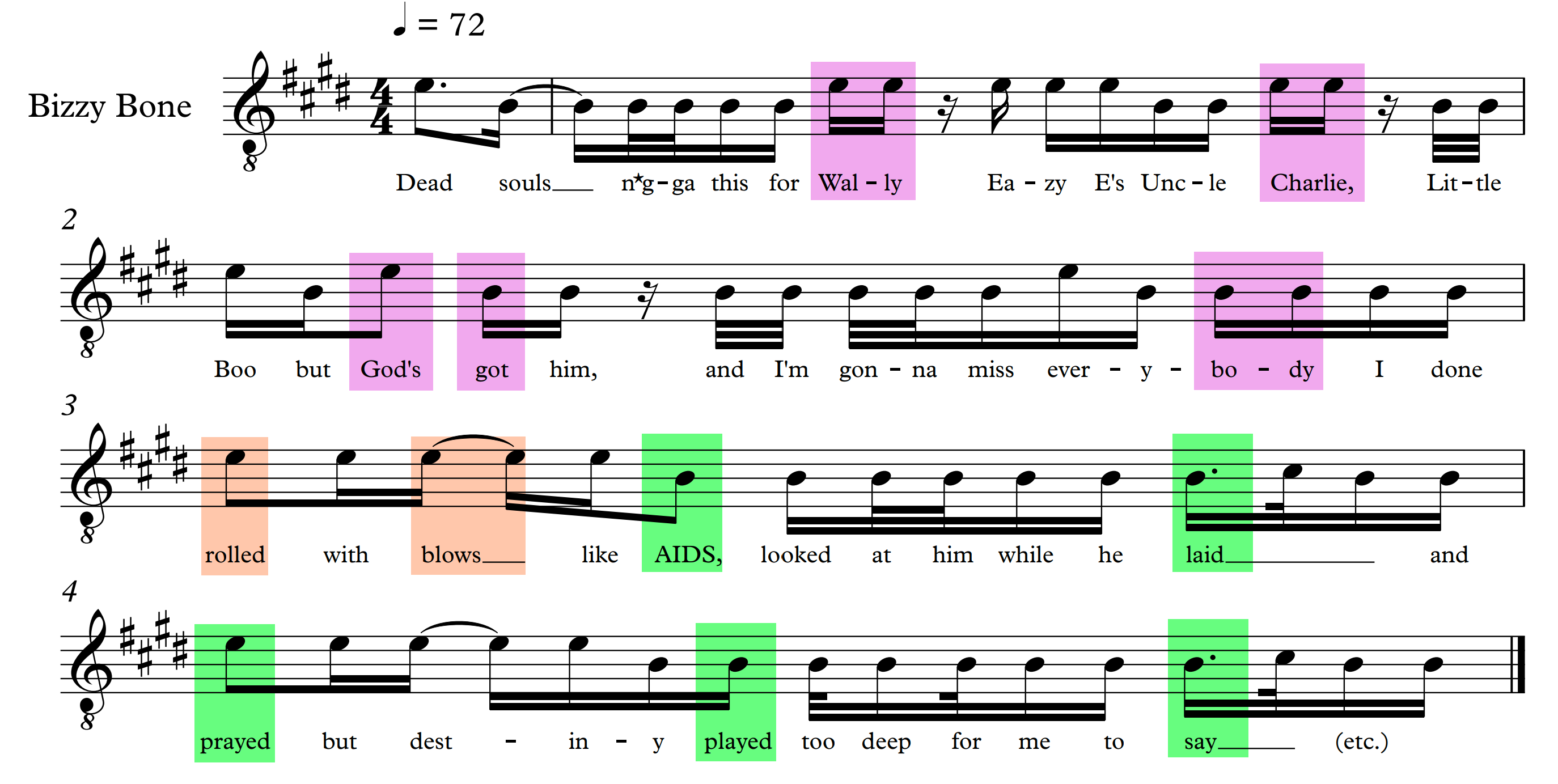
The chanting, syllabic, and pitched flows of Bone Thugs-n-Harmony have indirectly influenced rappers well into the 2010s. Example 18 shows an exemplary verse from Kendrick Lamar’s “Swimming Pools (Drank)” (2012), in which the rapper can be heard “singing” his lyrics on a highly-constrained group of pitches. Again, we can observe that Lamar’s flow strictly adheres to the background tonic of B minor. Particularly noteworthy in this example is Lamar’s tendency to use an identical melodic cell for rhymed syllables. As is shown in Example 18, each two-syllable rhyme is part of a larger four-note motive, which is similar in each highlighted occurrence. By using this repeated melodic cell, Lamar creates a type of “melodic rhyme” that functions concurrently with the rhymes in his lyrics. To show this, I have highlighted each “rhymed” four-note melodic cell in light red, while highlighting each of their smaller two-note lyric rhymes in dark red.
Occasionally rappers will perform a precisely pitched verse that is more melodic in character than Lamar’s chanting in Example 18. Example 19 shows a transcription of Chance the Rapper’s guest verse in DJ Khaled’s “I’m the One” (2017), which also features sung verses from rappers Quavo and Lil Wayne, and a sung hook by Justin Bieber. As can be seen in the example, Chance performs his verse using a G major pentatonic scale, spanning over an octave in range, with repeated melodic motives as well as a variety of gestures. There is even a moment in which Chance injects some dissonance into the pop standard I–vi–IV–V chord progression—note his repeated singing of the tonic over dominant harmony in measure 4 and $$\hat3$$ in measures 11 and 15 over a IV triad. Additionally, Example 19 demonstrates that Lamar is not alone in his use of “melodic rhymes” to strengthen existing lyrical rhymes. There are three primary rhymed groups in Example 19, shown in blue, red, and green. Chance assigns each of these rhymed groups their own short motive, each distinct from the others. To an extent, what Chance does in “I’m the One” is similar to the “rhyme strengthening” use of pitch shown in Section 2.1—the main difference being the level of clear intention behind his purposefully pitched melody.
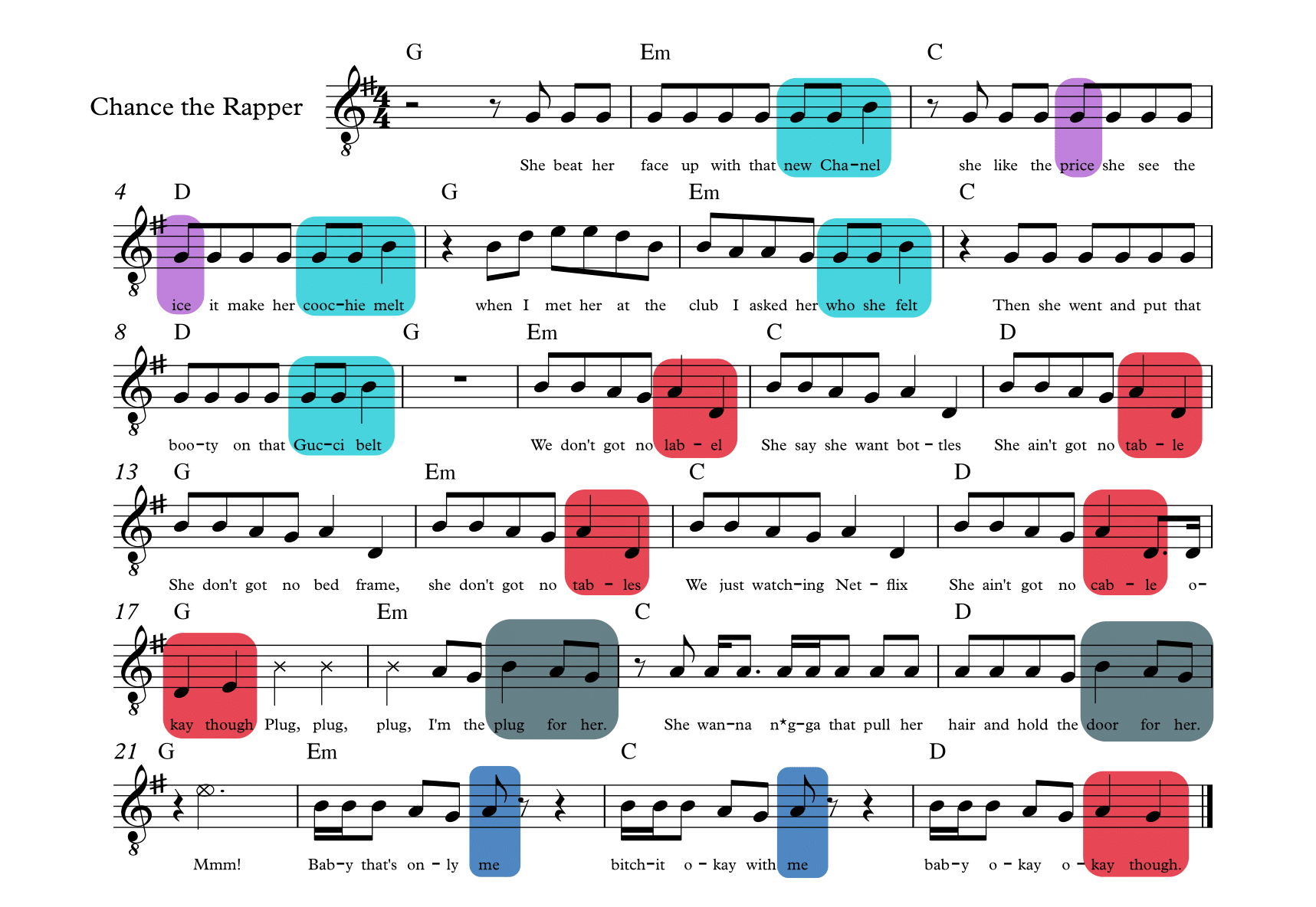
3. Genre Classification and Conclusion
The style of rap flow shown in Example 19 creates a genre classification problem. There are few concrete features that separate a rap verse like that seen in Example 19 from a verse in any melodic pop music track—in fact, Chance the Rapper uses a wider array of pitches in his performance than is utilized in many verses by pop singers, which tend to be more restrained in range to contrast an inevitable belting chorus. For an example of this, see Example 20—a transcription of the verse of Katy Perry’s recent single “Bon Appétit” (2017), which is arguably less “melodic” or “sung” than Chance the Rapper’s verse in Example 19.
This raises a genre classification issue with no easy answer. It certainly seems safe to allow performers to classify themselves: Singers sing, rappers rap. Since rapping is usually defined by the very fact that it is not singing, however, performances like that in Example 19 put us in a confusing situation. Thanks to the professional alias that Chance the Rapper has chosen, there can be little doubt as to whether he identifies more as a singer or a rapper. That said, what are we to make of examples like Examples 16–19 of this article, in which each an argument could be made that what each rapper performs is more singing than it is rapping? Could we, in an effort to compromise, agree that a performance can be considered both rapping and singing, despite the two vocal styles typically being discussed as diametrically opposed? Perhaps these borderline cases could be classified considering other factors: style, fashion, lyrics, timbre, method of production, or any indication from the artist as to which genre they feel they represent.18 Ultimately, the issue is more of a problem for analysts than it is for performers. Regardless of how I or anyone else classify Chance the Rapper, Kendrick Lamar, Nelly, or any other rappers that sing in their tracks, they are unaffected by said classification, and will likely continue to present themselves as rappers.
I contend that the question of rapper or singer be left to the artists themselves. If we view rapping as more of a technique that can be employed than a specific, gated genre of music, our understanding of hip-hop music is much more complete. In short: Analysts should concern themselves with what is happening in the realm of rap music and resist the urge to nitpick over whether a rapper has misclassified themselves. If we accept that all the rappers mentioned in this article are indeed rappers, performing in their own unique way, we can move on to discuss a broad range of techniques and styles that are used in hip-hop music more generally.
Pitch techniques in rap flows exist on a spectrum of precision, ranging from barely noticeable techniques that could very well be holdovers from the performers’ speech patterns to purposeful and melodic singing of rap lyrics. Despite pitch being one of the last parameters analysts typically remark upon when discussing rap flows, understanding and recognizing the techniques above are essential for music theorists hoping to become increasingly conversant with the genre of rap music.
Robert Komaniecki
93 E. Burlington St.
Iowa City, IA 52242
robert-komaniecki@uiowa.edu
References
Adams, Kyle. 2008. “Aspects of the Music/Text Relationship in Rap.” Music Theory Online 14 (2).
—————. 2009. “On the Metrical Techniques of Flow in Rap Music.” Music Theory Online 15 (5).
Bark, Theo. 2011. “Ja Rule Apologizes for Leading the Singing Rap Movement.” The Boombox. http://theboombox.com/ja-rule-apologizes-for-leading-the-singing-rap-movement/.
Berry, Michael. 2018. Listening to Rap: An Introduction. Routledge.
Bone, Bizzy. 2015. “Bizzy Bone Discusses Evolution of Bone Thugs-N-Harmony’s Style.” Interview by Henry Mansell. https://hiphopdx.com/news/id.32687/title.bizzy-bone-discusses-evolution-of-bone-thugs-n-harmonys-style#.
Celce-Murcia, Marianne, Donna M. Brinton, and Janet M. Goodwin. 1996. Teaching Pronunciation: A Reference for Teachers of English Speakers to Other Langauges. Cambridge University Press.
Condit-Schultz, Nathaniel. 2016.”Mcflow: A Digital Corpus of Rap Transcriptions.” Empirical Musicology Review 11. http://emusicology.org/article/view/4961/4496.
Deutsch, Diana. 1995. “Speech to Song Illusion.” http://deutsch.ucsd.edu/psychology/pages.php?i=212.
Edwards, Paul. 2009. How to Rap: The Art and Science of the Hip-Hop MC. Chicago Review Press.
—————. 2013. How to Rap 2: Advanced Flow and Delivery Techniques. Chicago Review Press.
Fery, Caroline. 2016. Prosody and Intonation. Cambridge University Press.
Heidemann, Kate. 2016. “A System for Describing Vocal Timbre in Popular Song.” Music Theory Online 22 (1). https://mtosmt.org/issues/mto.16.22.1/mto.16.22.1.heidemann.html
Komaniecki, Robert. 2017. “Analyzing Collaborative Flow in Rap Music.” Music Theory Online 23 (4). http://mtosmt.org/issues/mto.17.23.4/mto.17.23.4.komaniecki.html.
Krims, Adam. 2000. Rap Music and the Poetics of Identity. Cambridge University Press.
Ladd, R.D. 1996. Intonational Phonology. Cambridge: Cambridge University Press.
Limbong, Andrew. 2018. “The Voice Behind One of Hip-Hop’s Most Famous Hooks.” NPR. September 18. https://www.npr.org/2018/09/18/648850102/the-voice-behind-one-of-hip-hops-most-famous-hooks.
List, George. 1963. “The Boundaries of Speech and Song.” Ethnomusicology 7 (1): 1–16. Accessed 9/19/2018.
Manabe, Noriko. 2006. “Globalization and Japanese Creativity: Adaptations of Japanese Language to Rap.” Ethnomusicology 50 (1): 1–36.
McClary, Susan, and Walser, Robert. 1990. “Start making sense! Musicology wrestles with rock.” In On Record: Rock, pop, and the written word, edited by Simon Frith and Andrew Goodwin, 277–292. London: Pantheon Books.
Nelly. 2010. “Interview: Nelly Talks His Influence on Singing Rappers, ‘5.0’ & His Relationship with Ashanti.” Interview by Ernest Baker. October 6. Complex. https://www.complex.com/music/2010/10/interview-nelly-talks-his-influence-on-singing-rappers-5-0-his-relationship-with-ashanti.
Ohriner, Mitchell. 2019. “Analysing the pitch content of the rapping voice.” Journal of New Music Research 48 (5): 413–433.
—————. 2016. “Metric Ambiguity and Flow in Rap Music: A Corpus-Assisted Study of Outkasts’s ‘Mainstream’ (1996).” Empirical Musicology Review 11. http://emusicology.org/article/view/4896/4498.
Orejuela, Fernando. 2015. Rap and Hip-Hop Culture. Oxford University Press.
Genius: “Vice City” Discussion. 2015. https://genius.com/Jay-rock-vice-city-lyrics.
Sinnreich, Aram. 2010. Mashed Up: Music, Technology, and the Rise of Configurable Culture. Amherst: University of Massachusetts Press.
Williams, Justin A. 2009. “Beats and Flows: A Response to Kyle Adams, ‘Aspects of the Music/Text Relationship in Rap.’” Music Theory Online 15 (2).
—————. 2011. “Historicizing the Breakbeat: Hip-Hop’s Origins and Authenticity.“ Lied Und Populäre Kultur / Song and Popular Culture 56: 133–67.
—————. 2013. Rhymin’ and Stealin’: Musical Borrowing in Hip-Hop. University of Michigan Press.
—————, ed. 2015. The Cambridge Companion to Hip-Hop. Cambridge. United Kingdom: Cambridge University Press.
Notes
- All transcriptions in this article are my own.
- For exemplary tracks, see “99 Problems” (2003) by Jay-Z, “Till I Collapse” (2002) by Eminem, and “Really Doe” (2016) by Danny Brown.
- The present article is primarily focused on English rap, and thus will not go into issues of rapping in other languages, including tonal languages. There is precious little English-language scholarship on non-English hip-hop, though Manabe (2006) writes on adapting the Japanese language to rap, which presents as a challenge due to cultural insignificance of rhyme in Japan. One would imagine that rapping in tonal languages presents an additional layer of complexity, as the meaning of words is inextricably bound to their pitch contour. However, at this time no scholarly literature exists that deals with this topic.
- This is to say nothing of the myriad of timbral techniques employed by popular vocalists, on which several articles and monographs have been written. While the nuances of vocal timbre are outside the scope of this essay, interested readers should begin with Heidemann (2016).
- Auto-Tune (an audio processor that “snaps” recorded vocals to one of a chosen set of pitches) is widely used in popular music, with hip-hop being no exception. For the purposes of this article, I think of Auto-Tune primarily as a production tool and a means to an aesthetic end, rather than its own vocal delivery category. This decision is in part due to the fact that not all uses of Auto-Tune are easily perceptible, as it can be used quite subtly. That said, Auto-Tune is certainly a factor in whether or not a vocal performance is “purposefully” pitched, and more study on the use of this processor in popular music is needed.
- I specify that I’m referring to Eminem’s vocal range on this track, rather than in general, due to the fact that Eminem’s speaking voice is much lower than most of his recorded rapping.
- The credit for observing this phenomenon in this track belongs entirely to Alissandra Reed, who was kind enough to clue me in to it after an SMT presentation (2019, Columbus).
- While each example of rhyme strengthening that I have highlighted in this article uses three approximate pitch zones, rappers can and do utilize this technique while using more or fewer than three pitch zones.
- For another example, see “dimples would help” and “sits on the shelf” in Figure 2b.
- For an example of this phenomenon, imagine a judge stating “This case is now resolved.”
- This speech pattern is also sometimes called “Valley Girl Speak,” thanks to its popularization through young actresses in television shows taking place in California in the 1980s.
- For an extended discussion on rappers taking on each other’s flows in shared tracks, see: Robert Komaniecki (2017).
- It’s difficult to say with certainty the order in which verses are written and recorded on collaborative tracks like “Vice City.” What we can say for certain is that the use of pitch in this track unifies the flows of each rapper.
- Edwards (2013, 104) observes the same phenomenon.
- Rhonda Parris is actually covering Lyn Collins’s “Think (About It)” (1972) on the track “It Takes Two,” at the request of Profile Records. See also Andrew Limbong (2018).
- Countless examples exist, but some notable tracks include: “Where is the Love” (2003) by The Black Eyed Peas, hook sung by Justin Timberlake (and Fergie, group member; “Slow Jamz” (2003) by Kanye West feat. Twista, hook sung by Jamie Foxx; “Pimpin’ All Over the World” (2005) by Ludacris, hook sung by Bobby V; and “Empire State of Mind” (2009) by Jay-Z, hook sung by Alicia Keys.
- Some examples of tracks in which rappers sing their own hooks include: “I’m Real” (2001) by Ja Rule feat. Jennifer Lopez; “Cleanin’ Out My Closet” (2002) by Eminem; and “P.I.M.P.” (2003) by 50 Cent.
- Vocal timbre is undoubtedly influential when subjectively determining genre. While a discussion of vocal timbre in popular song is outside the scope of this paper, I again urge interested readers to consider Kate Heidemann’s 2016 article in Music Theory Online on this very topic.
